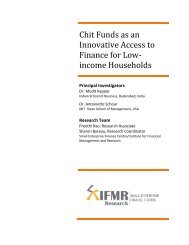Government of India Volume I: Analysis and Recommendations
Government of India Volume I: Analysis and Recommendations
Government of India Volume I: Analysis and Recommendations
Create successful ePaper yourself
Turn your PDF publications into a flip-book with our unique Google optimized e-Paper software.
CONSUMER PROTECTION<br />
The consumer protection part <strong>of</strong> the draft Code has three components: an enumerated<br />
set <strong>of</strong> rights <strong>and</strong> protections for consumers, an enumerated set <strong>of</strong> powers in the<br />
h<strong>and</strong>s <strong>of</strong> the regulator, <strong>and</strong> principles that guide what power should be used under what<br />
circumstances. The details <strong>of</strong> consumer protection would, <strong>of</strong> course, lie in the subordinated<br />
legislation to be drafted by financial regulators. Whether or not, for example, loads<br />
<strong>and</strong> other conflicted remuneration structures should be banned is a question that would<br />
need to be addressed by the regulator. The regulator will use its authority to develop<br />
subordinate legislation which will adapt over the years to reflect financial innovation,<br />
technological change, <strong>and</strong> the evolving nature <strong>of</strong> the <strong>India</strong>n economy. Alongside this<br />
regulation-making m<strong>and</strong>ate, the regulator would also have supervisory roles to ensure<br />
compliance with the law.<br />
In <strong>India</strong>, so far, the financial regulatory structure has been defined by sector, with<br />
multiple laws <strong>and</strong> <strong>of</strong>ten multiple agencies covering various sectors. This has led to inconsistent<br />
treatment, <strong>and</strong> regulatory arbitrage. Regulators have sometimes been lax in developing<br />
required protections out <strong>of</strong> notions <strong>of</strong> facilitating growth in the industry. These<br />
problems would be reduced by having a single principles-based law which would cover<br />
the entire financial system. The Commission believes that an overarching principlesbased<br />
body <strong>of</strong> law would allow regulatory flexibility, consistent treatment <strong>of</strong> consumers<br />
across all aspects <strong>of</strong> their engagement with the financial system, fairness <strong>and</strong> ultimately<br />
a more stable financial system.<br />
Turning from prevention to cure, the Commission proposes the creation <strong>of</strong> a unified<br />
financial redress agency. The redress agency is expected to have front-ends in every<br />
district <strong>of</strong> <strong>India</strong>, where consumers <strong>of</strong> all financial products will be able to submit<br />
complaints. Modern technology will be used to connect these front-ends into a centralised<br />
light-weight adjudication process. A well structured work-flow process will support<br />
speedy <strong>and</strong> fair h<strong>and</strong>ling <strong>of</strong> cases. Consumers will deal only with the redress agency<br />
when they have grievances in any financial activity: they will not have to deal with multiple<br />
agencies.<br />
The complaints brought before the redress agency will shed light on where the problems<br />
<strong>of</strong> consumer protection are being found, <strong>and</strong> thus suggest areas for improvement in<br />
subordinated legislation. As such, a key feature <strong>of</strong> the redress agency will be the creation<br />
<strong>of</strong> a feedback loop through which the computerised case database <strong>of</strong> the redress agency<br />
will be utilised by the regulator to make better regulations on a systematic basis.<br />
<strong>India</strong> needs a capable financial system, with sophisticated private financial firms.<br />
However, the emergence <strong>of</strong> this financial system should not become a carte blanche for<br />
clever financial firms who achieve undue influence with their regulators, to take unfair<br />
Table <strong>of</strong> <strong>Recommendations</strong> 5.1 Framework on consumer protection<br />
The draft Code contains a consolidated non-sector-specific financial consumer protection framework. It identifies<br />
consumer protection as a key regulatory objective <strong>and</strong> contains the following preventive <strong>and</strong> curative components:<br />
1. Preventive tools<br />
◮ Certain protections are provided to all financial consumers.<br />
◮ An additional set <strong>of</strong> protections are provided to unsophisticated or retail consumers.<br />
◮ The regulator is given a list <strong>of</strong> enumerated powers which it can use in order to implement these protections.<br />
◮ The regulator will be guided by a list <strong>of</strong> principles that should inform the exercise <strong>of</strong> its powers.<br />
◮ The regulator has been given the power to supervise financial service providers <strong>and</strong> initiate enforcement<br />
<strong>and</strong> disciplinary actions.<br />
2. Curative tools<br />
◮ Creation <strong>of</strong> an independent financial redress agency to redress complaints <strong>of</strong> retail consumers against<br />
all financial service providers.<br />
◮ A research program, applied to the data emanating from the redress agency, will feed back to the<br />
regulator <strong>and</strong> thus enable improvements in its work.<br />
44 FINANCIAL SECTOR LEGISLATIVE REFORMS COMMISSION



